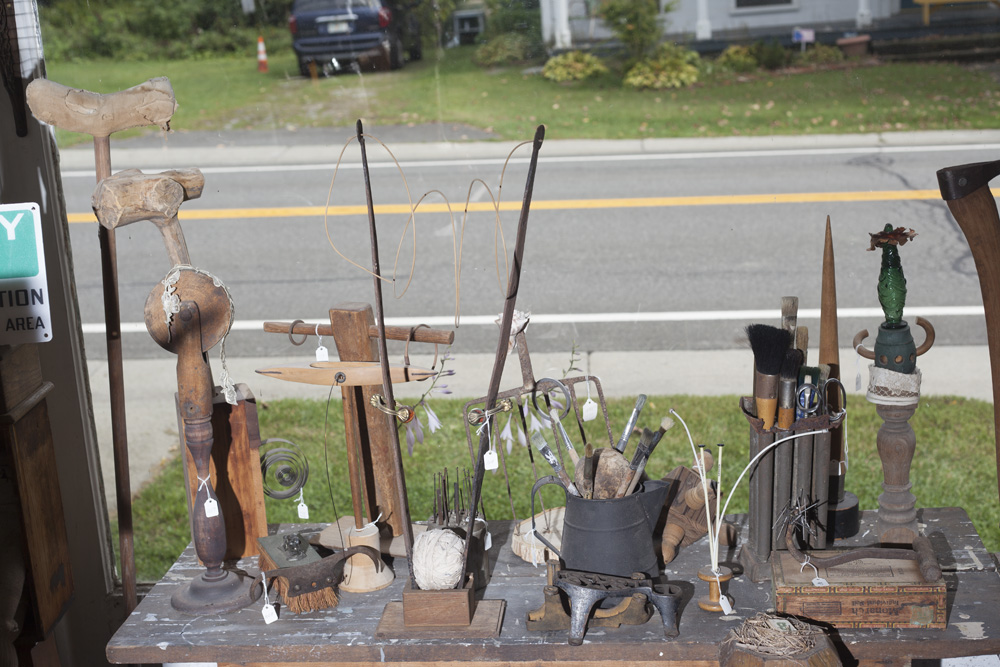When I pulled up in front of artist Norman Hasselriis’s storefront gallery in the tiny town of Oak Hill, New York, the lights were off and the door was closed, as they’d been most days since 2006, when Hasselriis had died at the age of eighty-seven. I was there to meet his retired daughter, Connie, and her husband Roger, who were going to show me the 1200-some sculptures he’d left behind, his roughhewn assemblages (as Hasselriis called them) made from flea market flotsam.
Instead, almost immediately after I arrived at the gallery, another car pulled up, boxing me in. An old man with a grey-yellow beard, a thick wooden walking stick, and a nearly impenetrable Polish accent tumbled out.
“Tadeusz,” he introduced himself. He was a sculptor too, and a friend of Hasselriis. Hasselriis had visited his workshop some fifteen years ago, and today he’d decided to return the favor.
Did he know that Hasselriis had passed, I asked? Yes, he told me, years ago. Had he also arranged a visit with Connie and Roger? No, he said, he’d just shown up. Today felt like the day. I would soon come to learn that this kind of human interaction was Hasselriis’ raison d’être (or at least, his raison d’art).
Together, Tadeusz and I contemplated the window of Hasselriis’s store, The Assemblage. Dozens of anthropomorphic faces stared back at us—a tennis racket wearing a wig of old black lace and a pair of pince-nez glasses; a translucent blue plastic bust with a baby doll stuffed inside it; a pitchfork, stuck in a piece of wood, decked out in a bridal veil. Most—perhaps all—of Hasselriis’ sculptures suggest life with a bare minimum of signifiers, giving them a glimmer of humanity that does nothing to hide their object-ness. Both the humor and the uncanny nature of his work lie here, in its approximation of life.

Finkelstein points to the case of Henry Darger, perhaps the most celebrated outsider artist in the American canon. Darger, who lived his life in and out of institutions, died in a room so small that he was never able to fully unfurl his giant canvases, which illustrated his 15,000 page manuscript The Story of the Vivian Girls, in What is Known as the Realms of the Unreal, of the Glandeco-Angelinnian War Storm, Caused by the Child Slave Rebellion. Darger’s landlords—one of whom was a photographer for The New York Times—discovered his work after he died, and his canvases now sell for hundreds of thousands of dollars. Darger needed an insider to validate (and valuate) his work for the art world, which is the kind of recognition that Hasselriis walked away from decades ago. If he didn’t want it while he was alive, is it disrespectful to pursue it after his death?
Regardless of this tension, Finkelstein still believes that “the greater good of seeing the work… is more useful than having it disregarded because it's tainted by capitalism.” If Connie and Roger can create some kind of institution that keeps Hasselriis’s work together and connected to the place he loved, they may be able to preserve his vision without sacrificing his spirit.
And despite the nine years that have passed since his death, Hasselriis’s vision still draws visitors, like myself and Tadeusz, Hausmann and Bland. The monetary value of his work may be impossible to assess, but the emotional power of it is visible to anyone who drops in. Through his sculptures—his playthings—Hasselriis’s spirit still animates The Assemblage. Every time I walk through the door, it feels as though the sculptures have only just sat still, and every time I leave, like Hasselriis himself, I have the urge to say goodbye to each one, hoping it won’t be the last time I see them.






